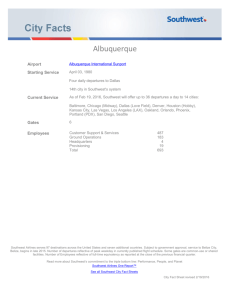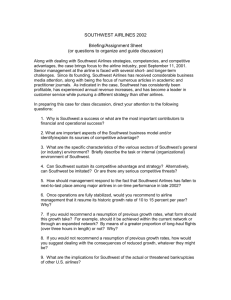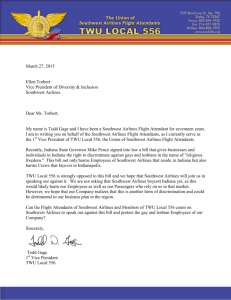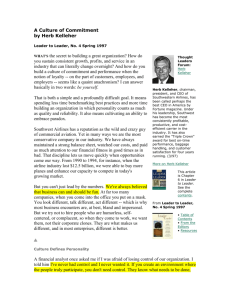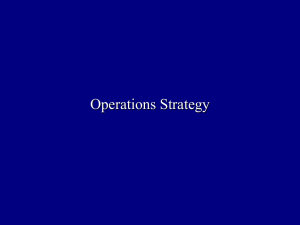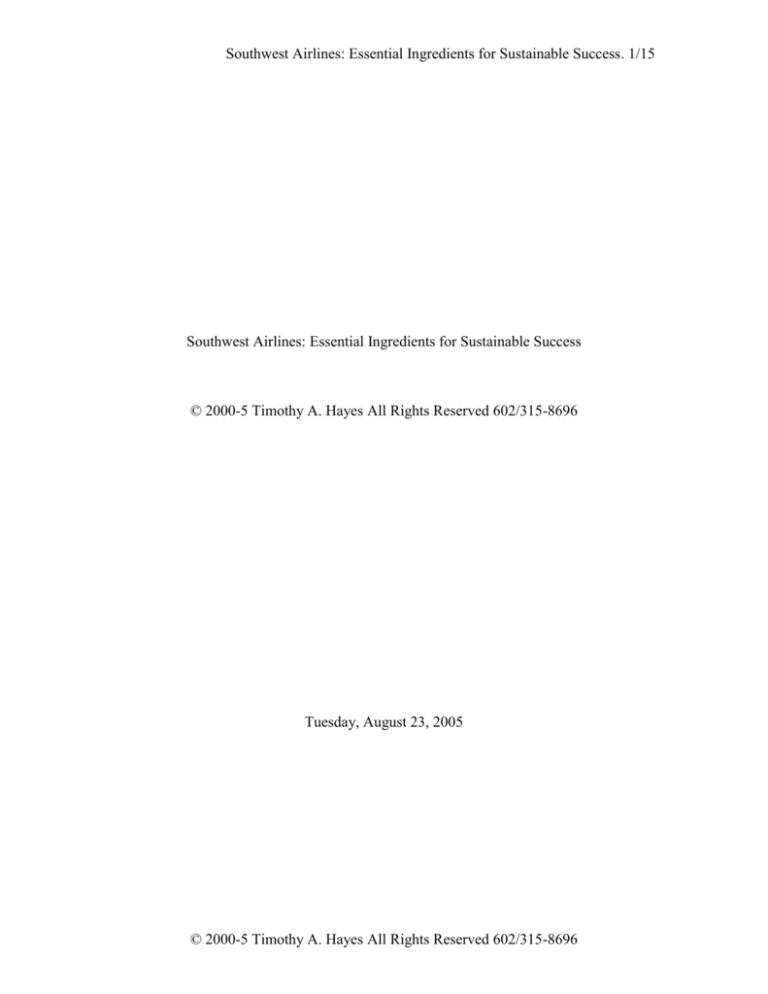
Southwest Airlines: Essential Ingredients for Sustainable Success. 1/15
Southwest Airlines: Essential Ingredients for Sustainable Success
© 2000-5 Timothy A. Hayes All Rights Reserved 602/315-8696
Tuesday, August 23, 2005
© 2000-5 Timothy A. Hayes All Rights Reserved 602/315-8696
Southwest Airlines: Essential Ingredients for Sustainable Success. 2/15
Preface
This discourse is written (or was attempted to be written) in accordance with Southwest
Airlines culture and policy. In coordination with the general tenure and periodicity of
this essay, being the final treatise in the consummation of not only this distinguished
curriculum, but also that of the whole, this essay attempts to add a bit of humor and light
reading while still conveying meaningful information and directing management
attention to important, relevant, and timely information regarding Southwest’s position,
strategy, strategy execution, and future performance.
© 2000-5 Timothy A. Hayes All Rights Reserved 602/315-8696
Southwest Airlines: Essential Ingredients for Sustainable Success. 3/15
Introduction: How to Bake an Airline Cake
Start with determined management, mix in 2/3 cup legal counsel, three favorable
regulations, half an ounce of grade A strategy, 1/3 cup of peanuts (bagged), a dash of
luck, bake at 35,000 feet for an average of 1.5 hours,
Nutritional Stats (2005)
Serving Size: 1 Airline (417 Aircrafts)
Serving Size Per Container: About 1
and what do you get? The answer is Southwest
Airlines. It is not any one ingredient: the brilliant
Amount Per Serving
Market Cap: 10.46 B
execution of strategy, winning legal and regulatory
% or Value
P/E
Trailing
Forward
Margins
Profit
Operating
Revenue
Earnings Growth
Revenue Growth
Debt to Equity
battles, corporate culture, customer base, or technology
26.81
22.9
5.90%
9.82%
13.30%
40.70%
0.318
alone that has led to Southwest’s success in the airline
industry. Rather, it is the compilation of many factors
into a strategy that has kept Southwest flying high for
almost 40 years.
The Nuts behind our Success
There are several factors in our success that deserve recognition. But be
forewarned, the first factor may come as a surprise to those who have already
predetermined that the success of Southwest is primarily due to corporate culture. This,
of course, does not demean culture as runner up in any way. A cake would taste lousy
without sugar, and Southwest would fly a few thousand feet lower with its fun loving
culture. However, most people viewing an incredible rendition of The Phantom of the
Opera or Cats are focused on the actions of the spotlight and not the brilliant design of
the stage. The stage, the invention of Southwest that supports its structure and operations
behind the scenes was an entirely new way to look at travel. Instead of Hub and Spoke
© 2000-5 Timothy A. Hayes All Rights Reserved 602/315-8696
Southwest Airlines: Essential Ingredients for Sustainable Success. 4/15
design offering inefficient and high cost means of passenger flight, the founders of
Southwest invented a way to make flight cheap and quick enough to compete with other
means of travel both economically and practically. No one had ever thought in this way
before. It was an invention of extraordinary significance that would change the airline
industry forever.
Southwest started in a time of regulation of the airline industry and lived through
deregulation, eventually growing into a giant. Culture, employee attitude, and financial
stewardship certainly had their moments in the shaping Southwest. However, I would
argue that it is the original invention of low cost flight, a disruptive technology, that
enabled flight to cost compete with ground transportation for short distances that
fundamentally changed the industry. The changes it caused in the industry were not
merely incremental. The consequence of the invention was two-fold. First, other
airlines, such as JetBlue, copied the invention successfully in other countries and
markets. Second, it jeopardized older established airlines who could not copy or
purchase the invention due to the huge cost and capital investment necessary to leave
their hub-and-spoke models and enter the market in the same way. Just as a disruptive
technology such as VHS or DVDs slowly grows until it reaches critical mass and then
changes the dynamics of the market, Southwest airlines started as the niche market and
grew into the industry standard – toppling older technologies. It is now the high-cost hub
and spoke airlines that have been forced down to occupy the diminishing high-cost niche
market.
What did this invention do? It created a market that never existed before and led
to another complementary invention: the ability to price discriminate based on two
© 2000-5 Timothy A. Hayes All Rights Reserved 602/315-8696
Southwest Airlines: Essential Ingredients for Sustainable Success. 5/15
different types of travel. The new market segment that was created consisted of the
option for price sensitive (elastic) vacationers to purchase low cost (but above variable
costs) seats to keep the plane full while at the same time making substantial profits on
business consumers who needed to purchase tickets on the “fly” and were not as price
sensitive (inelastic).
The older legacy airline models were left to primarily the latter
market because their costs would not be sustained indefinitely without the influx of price
sensitive consumers.
Naturally, other tangents to the original invention also helped to further reduce
costs. Even the fun culture and atmosphere reduced cost by increasing customer
satisfaction with less employees per seat mile and therefore lower labor expenses.
Ticketless travel and a simple, easy to use internet web-site design led to lower customer
complaints, ticketing issues, and overall operational expenses. All of these are tangent
strategies and byproducts that compliment and extend the original invention.
However,
these strategies are more easily copied by the legacy airlines and should not be confused
as the distinctive competency and technological invention that revolutionized passenger
aircraft travel.
Why does Southwest Fly Higher?
Southwest’s genius was originally encapsulated in our ability to take market share
not only from the airline market, but also from the general transportation market. By
lowering costs and prices to near or below other means of transportation and decreasing
wait times, we were able to capture a fair portion market from buses, automobiles, and
other transportation methods. Legacy airlines with hub and spoke technology could not
compete on a cost or time basis without completely revamping their business model and
© 2000-5 Timothy A. Hayes All Rights Reserved 602/315-8696
Southwest Airlines: Essential Ingredients for Sustainable Success. 6/15
corporate structure. However, it must be noted that newer entrants such as Ryan Air
(Europe) and Jet Blue may be able to compete using the same technology, low cost
structure, and market niche as Southwest.
While discussing the success of Southwest, we cannot neglect the execution of
strategy in excellent management methods and corporate culture. The financial
management of funds to fly in both good times and bad are what allowed us to stay
profitable before and after September 11th. It is the corporate culture of employees’ first,
customers second, and a fun atmosphere that has kept us on top from a customer relations
perspective. Not only does this culture spur customer satisfaction, it also decreases cost.
Employees are willing to work for lower salaries, have better job satisfaction, and
experience lower turnover rates - all leading to lower operational expenses. We must
continue to foster this culture.
Analyses of Costs
In the end, all of the ingredients after being boiled down and baked for 22,000
feet add up to lower costs, lower priced tickets, and a greater number of travelers. As
noted in Figure 2, Southwest has managed to keep costs lower than most competitors. In
all areas of operations, Southwest has sought
Table 1: Fuel as a Percentage of
Operating Expenses
Year
Fuel/ASM
OE/ASM Fuel/OE
1995
1.01
7.09 14.25%
2000
1.38
7.72 17.88%
2001
1.29
7.48 17.25%
2002
1.17
7.36 15.90%
1
2005
1.55
7.81 19.85%
to keep prices as low as possible. However,
there is one operational expense for which
Southwest has limited control. The trend that
is most noteworthy is the increasing cost of
fuel, a trend that is clearly visible when the cost of fuel per average seat mile is compared
to total operational expenses (TOE). Since 2000, fuel costs have increased by 2.5%
1
Annual Report (10-K): Southwest Airlines, 2005
© 2000-5 Timothy A. Hayes All Rights Reserved 602/315-8696
Southwest Airlines: Essential Ingredients for Sustainable Success. 7/15
relative to TOE - even after futures contracts and hedging have been implemented. This
percentage should significantly increase later years since hedging can only counter fuel
prices in the short run. The basic principle behind Southwest Airlines is to minimize
costs. To accomplish this we need to pay close attention to all costs, with particular
attention to labor and fuel. Figure 1 shows fuel as a percentage of TOE, figure 2 shows
TOE for Southwest relative to competitor airlines.
Fuel as a Percentage of Operating Expenses
25.00%
20.00%
15.00%
Fuel as a Percentage of
Operating Expenses
10.00%
5.00%
0.00%
1995
2000
2001
2002
2005
Figure 1: Fuel as a Percentage of Operating Expenses. (Quarterly Report (10-Q): Southwest Airlines,
2005).
© 2000-5 Timothy A. Hayes All Rights Reserved 602/315-8696
Southwest Airlines: Essential Ingredients for Sustainable Success. 8/15
Operational Cost by Airline
16
Cents per Average Seat Mile
14
American
12
Alaska
Continental
10
Delta
8
America West
Northwest
6
Southwest
United
4
UsAirways
2
0
1995
2000
2001
2002
Year
Figure 2: Operational Cost by Airline per Average Set Mile
Thunderstorms and other Threatening Weather
There are three threats to the future success of Southwest Airlines. In third place
is industry patterns that may equally threaten all airlines in the industry. 2nd place
belongs to changes in the legal environment that may threaten our culture. But by far, the
first place winner is a change in the energy market that may cripple our original invention
of low cost flight and the airlines ability to compete with other means of transportation
for the large leisure travel market.
3rd Place: Is the Industry Losing Altitude?
The airline industry has been facing significant turbulence since two years before
September 11th through today. Several airlines have been forced into bankruptcy and it
is estimated that US Air and Delta may be forced back in to the pit of financial disaster as
soon as late 2005 or early 2006. This provides an opportunity for Southwest to gain
© 2000-5 Timothy A. Hayes All Rights Reserved 602/315-8696
Southwest Airlines: Essential Ingredients for Sustainable Success. 9/15
market share using its low cost, high visibility way of managing flights. However, it also
shows some damaging changes in the travel industry. The main cause: people are
unwilling to pay the price to fly and are relying on other forms of transportation or simply
traveling less.
How does this affect Southwest Airlines? Southwest is composed of two markets,
leisure and business travelers.
For the business market, as businesses move to cut costs
they may allow less employee travel and affect the airline industry as a whole. From a
consumer standpoint, if disposable income decreases or inflation increases faster than
wage increases, people may have less disposable income for leisure flights. Both of
these could negatively impact the passenger flight industry.
2nd Place: The Legal Environment
Southwest’s culture attempts to be non-bureaucratic and fun. However, changes
in bureaucratic regulations, training, and other requirements may jeopardize Southwest’s
ability to stay non-bureaucratic by requiring increased uniformity and conformity to
hundreds of regulations. Fees associated with September 11th,changes in security, and
other legal matters greatly increased general operating expenses for many airlines.
Likewise, the extreme litigiousness of American society may also jeopardize Southwest’s
fun atmosphere. For example, two woman sued Southwest for saying “Eenie, Meenie,
Minie, Moe, pick a seat we gotta go” claiming “severe emotional distress”. It seems that
the only legal business culture anymore is a dry, boring, and bureaucratic “cannot do”
attitude. In this case and in the spirit and culture of Southwest, I would recommend
© 2000-5 Timothy A. Hayes All Rights Reserved 602/315-8696
Southwest Airlines: Essential Ingredients for Sustainable Success. 10/15
defending the employee and not giving in to the pressure from frivolous nursery rhyme
lawsuits2 as a matter of principle.
And the Winner Is: Fuel3
As stated earlier, Southwest’s original invention was a method to lower costs
enough to price compete with other means of transportation and therefore take both the
leisure and business markets while price discriminating between the two. The business
travelers are less price elastic and therefore tend to book tickets last minute for a higher
price. On the other end, leisure travelers tend to plan vacations in advance and are price
elastic and can book tickets for a lower price in advance. The basic model means that the
price of a seat increases as the day of travel approaches.
Here’s the kicker. This model relies on the ability to keep costs low enough to
attract short distance leisure travelers from using other means of transportation or
deciding to travel to closer locations. Unfortunately there is one big problem that may
greatly affect the future viability of this model: the price of energy. Fuel cost is the
second highest single expense for Southwest after labor and increased by almost 25%
from 2004 to 2005. Based on oil and energy trends, international demand from China
and India, and domestic energy usage, the increase in fuel cost is just beginning.
2
In 2004 we won the lawsuit, however, it still cost us triple digit legal fees. Yes, a judge did find that the
saying could violate the law, it took a lot of money to convince a jury that, in the context, the saying was
benign and innocent. Whatever happened to free speech? See
http://www.today.ucla.edu/2003/030225lawsuit.html for more information.
3
My analysis of the fuel problem was completely independent in thought and was based more on my
research on fuel for NanoCat™ technologies and my thesis. However, after reviewing Southwest’s current
10-K and other reports, I have found that the management at Southwest focuses on Fuel cost as well. The
foremost topic considered is fuel cost. They also included EXACTLY the same statistical analysis of fuel
cost as a percentage of Operating costs. View 10-K at http://yahoo.brand.edgaronline.com/fetchFilingFrameset.aspx?FilingID=3440257&Type=HTML. Judging from the amount of text
in the 10-K talking about fuel cost, it must be at the top of managements mind.
© 2000-5 Timothy A. Hayes All Rights Reserved 602/315-8696
Southwest Airlines: Essential Ingredients for Sustainable Success. 11/15
This adverse trend in oil prices affects two areas: first internal competition
between airlines, and Second, competition between airlines and the short and medium
distance transportation markets. Unfortunately, the intense competition within the airline
industry has kept airlines from being able to increase prices to reflect the increase fuel
cost. Airlines who have attempted to raise prices have only succeeded in losing market
share.
The largest problem with increased fuel prices, however, is not intra airline
competition, it is external competition and elimination of disposable income. The basic
principle is that on the one side of the value chain consumers less disposable income for
vacation travel because they have higher fuel expenses. On the other side, Airlines have
increased fuel expenses and which cannot be passed on to the leisure customer segment
due to a highly elastic demand. The airlines are squeezed in the middle, higher costs and
lower profits. Since much of our costs are fixed costs, lower volume at almost any ticket
price is damaging.
There are two ways that we are coping with the fluctuating and increasing oil
prices. The first is by hedging on oil futures. This works in short run, however,
hedging only allows us to fix prices for a given period of time4. If energy prices continue
to increase, prices will eventually have to be adjusted industry-wide. The second way is
to leverage technology to increase fuel efficiency. For example, adding winglets to our
4
“U.S. Airways would have had a 38 million profit last year instead of an 88
million loss if it had hedged.” (Carter, Rogers & Simkins, 2004). Fuel Hedging in the
Airline Industry: The Case of Southwest Airlines. From:
http://207.36.165.114/NewOrleans/Papers/8302208.pdf
© 2000-5 Timothy A. Hayes All Rights Reserved 602/315-8696
Southwest Airlines: Essential Ingredients for Sustainable Success. 12/15
737-700 models saved us $28 million in fuel in 2004 (Annual Report (10-K): Southwest
Airlines, 2004).
The trend, therefore, that will have the most dramatic affect on airline travel in
the long run is the price of oil and the ability of technology to counter the price in
different sectors. For example, if the price of gas goes from $1 average to $2 average
over a ten year period, this change is completely offset if vehicle efficiency doubles
during the same period (i.e. 15 miles to the gallon vs. 30 miles to the gallon). The
problem is that the technology advances for fuel efficiency to offset increases in fuel
prices will probably affect vehicles far in advance of jet engine technology. This will
mean that the cost of traveling by ground may increase at a much lower rate than the cost
of jet-travel. The trend may ultimately affect the decision of leisure travelers to avoid
airlines for short distance travel that can be done more efficiently and cost effective by
car. Table 1 gives an example of the phenomenon using Phoenix to San Diego as a basic
short distance trip.
Table 1: Technology Divergence and Between Industries Affecting Travel Decisions
Vehicle
Car
%Fuel Price
Year
Type
Mi/Gal
Cost
Ticket Price
Inc.
2005 CR-V
21.5 $101.86
$77
12%
2006 CR-V
21.5 $114.08
$86.24
12%
2007 CR-V
21.5 $127.77
$96.59
12%
2008 Hybrid
55
$55.94
$108.18
12%
2009 Hybrid
55
$62.65
$121.16
12%
2010 Hybrid
55
$70.17
$135.70
12%
2011 Hybrid
55
$78.59
$151.98
12%
2012 Hybrid
55
$88.03
$170.22
12%
2013 Hybrid
55
$98.59
$190.65
12%
2014 Hybrid
55 $110.42
$213.53
12%
2015 Fuel Cell
150
$45.35
$239.15
12%
2016 Fuel Cell
150
$50.79
$267.85
12%
2017 Fuel Cell
150
$56.88
$299.99
12%
2018 Fuel Cell
150
$63.71
$335.99
12%
© 2000-5 Timothy A. Hayes All Rights Reserved 602/315-8696
Travel
Choice
Plane
Plane
Plane
Car
Car
Car
Car
Car
Car
Car
Car
Car
Car
Car
Southwest Airlines: Essential Ingredients for Sustainable Success. 13/15
What’s Next? A Squirrels Guide to Protein Alternatives
It may be impossible to avoid the lull in short distance traveling due to the
divergence of prices for vehicle vs. airline cost of travel in a quickly rising fuel market
where ground travel is offset by technology and airline travel is not. However, Southwest
has kept the principles of low debt to equity ratios and other defensive mechanisms to be
able to function in both good times and bad. The cash reserves and low debt ratio of
0.318 can be capitalized to take market share from other airlines that will not be able to
compete in the changing industry. One alternative is to apply Southwest’s low cost
structure to longer routes where vehicle alternatives are unavailable. These routes can be
acquired from other carriers when they leave the market due to industry pressure.
Another alternative is to anticipate a long lull in the industry as it attempts to
reorganize and then use Southwest’s strong market position to gain market share and
hopefully boosts prices industry-wide after the dust settles. Eventually consumers will
have to pay higher prices to cover increases in fuel costs and the airlines that survive will
be the winners. Southwest should continue building its cash reserves to be ready for the
industry shake-down. Its probable that by 2020 or later newer engine technologies may
even help to counter increasing fuel prices. The question remains, who will survive until
then?
The biggest threat to Southwest’s future success is to miss the opportunity of
expansion during the lull. It is possible that other low-priced and well positioned carriers
such as Europe’s Ryan Air may try to enter the US market in a similar strategy.
Southwest should attempt to position itself as a local, US based company with close dies
to the community in order to counter moves from European discount and other
© 2000-5 Timothy A. Hayes All Rights Reserved 602/315-8696
Southwest Airlines: Essential Ingredients for Sustainable Success. 14/15
international carriers. This is where Southwest’s culture and fun-loving attitude may
bolster their ability to compete.
Recommendation: Expect a Lull but Continue Going Nuts!
Southwest needs to strengthen its defensive strategy and cash reserves in
anticipation of rising costs and intense industry competition. Furthermore, Southwest
should use financial hedging by purchasing futures contracts based on the price of oil. In
the long run, Southwest should wait until other major airlines begin to fail, then purchase
market share, routes, and perhaps even capital equipment such as planes at below market
value. This strategy should secure Southwest’s future dominance of the airline industry
in the United States.
© 2000-5 Timothy A. Hayes All Rights Reserved 602/315-8696
Southwest Airlines: Essential Ingredients for Sustainable Success. 15/15
References
Annual Report (10-K): Southwest Airlines. (2004, February 4). Management’s
discussion and analysis of financial condition and results of operations.
Quarterly Report (10-Q): Southwest Airlines. (2005, July 20). Revenues.
© 2000-5 Timothy A. Hayes All Rights Reserved 602/315-8696


